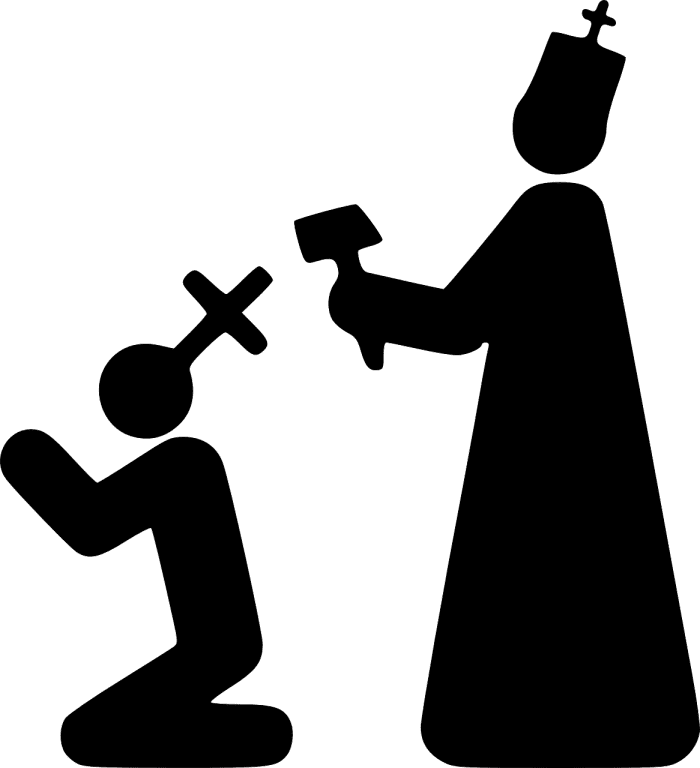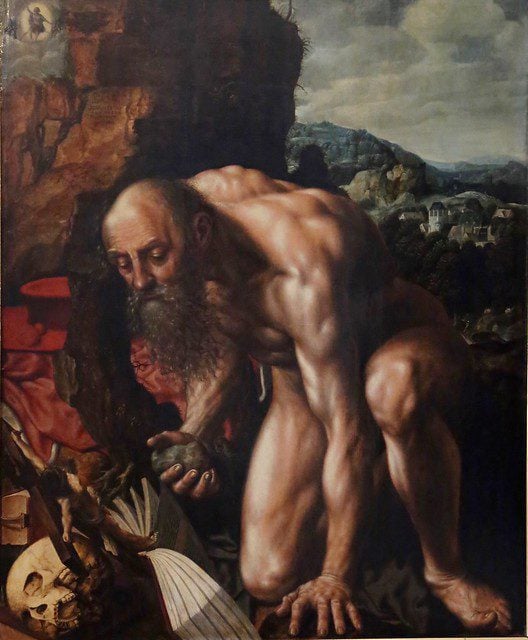I want to take a look at the relationship between homosexuality and the pedophilia scandals. I know that there are other writers who are simply saying “There is no relationship. Stop with the homophobic scapegoating already,” and that does need to be said. But it’s not likely to be all that effective in addressing the concerns and beliefs of those who sincerely believe that the problem comes down to too many gay priests, and too much sexual liberalism.
Proponents of the blame-the-gays thesis point out that there is a significant discrepancy between the victim demographics found in the John Jay Report and the demographics of child sex-abuse victims generally. Specifically, over 80% of those abused by priests were male, whereas normally female victims outnumber male victims two to one.
The authors of the John Jay Report concluded that this was largely a product of opportunity: priests had more access to boys and young men. Until recently, altar servers were exclusively male and some of the abuse that has been documented goes all the way back to the days of minor seminaries. Since many abusers are opportunistic, this would account for the discrepancy.
Critics of the report point out, however, that many of those abused were not pre-pubescent children. With pedophiles, we know that there is not necessarily any correlation between the preferred sex of child-victims and the preferred sex of adult partners. Some pedophiles have no adult sexual attractions at all. Many are largely indifferent to the sex of their victims.
But if the victims are not, strictly speaking, children but adolescents in the 11-17 age bracket, we aren’t necessarily talking about pedophilia, but ephebophilia.
We know that it is reasonably common for men to be attracted to minors. If nothing else, the popularity of “jail-bait” and “schoolgirl” porn attests to a fairly high population of straight guys who are attracted to underage girls. But these attractions are generally more indicative of sexual orientation. Straight ephebophiles like teen girls in short kilts, and gay ephebophiles like starry-eyed twinks.
So if we’re seeing a disproportionate number of adolescent male victims, doesn’t that suggest that we’re looking at a disproportionate number of homosexual offenders?
It kind of does. But this is not really shocking, because we have reasonably strong study data showing that rates of homosexuality in the Catholic priesthood are vastly greater than rates in the general population. Depending on the study, and the methodology and definition of “homosexuality” that is used, it’s found that rates of homosexuality among Catholic clergy are between 15 to 58%. This is orders of magnitude higher than the rates found among the general population where, again, depending on the study, the methodology and the definitions used, rates of homosexuality range between 1.5 to 10%.
The disproportion in victim demographics is really obviously reflective of this difference in sexual preferences. Obviously, if you take a group of straight men who are sex offenders, the majority (not all, but the majority) of their victims will be women. If you take a group of gay sex-offenders, the majority (again not all) of their victims will be men.
So if you have a profession where the rates of homosexuality are likely seven to seventeen times higher than average, you’re going to see that reflected in the victim demographics of people who have been sexually assaulted by members of that profession.
Okay. So the problem with sexual abuse in the Catholic Church is a problem of homosexuality, right?
In a sense, yes. Specifically, it’s a problem of the way that the Catholic Church deals with homosexuality.
Anyone familiar with this territory knows that internalized homophobia is deeply destructive. If the studies are accurate, the Catholic priesthood, as an institution, has a serious problem with internalized homophobia.
I’ve heard several people describe the effects of this in private, and what they’ve reported conforms pretty closely to what this interview at the American Conservative, and this article from the Times describe: a culture of secrecy in which fear of blackmail hinders accountability and where people who attempt to report are ignored, or even punished or pushed out for reporting. I’ve heard about this from liberals and conservatives alike. From people who are openly homophobic, and from people who are openly gay-positive.
The problem, simply, is that the Church has no open space for gay people. A gay man can’t get married. If he comes out of the closet, he can expect to meet hostility and suspicion within Catholic communities. Often when men do disclose, they are told to keep their sexuality a secret. Even today, I frequently encounter Catholics who tell me that my sexual orientation is a mental disorder, that I shouldn’t identify as queer, and that nobody needs to know except perhaps my confessor.
In practice, this means that boys who discover that they are gay within a Catholic context are often reluctant to admit it, to others or even to themselves. They know that they don’t want to get married, but they face pressures from parents and other relatives to find a nice girl and have a nice Catholic family. For many, the priesthood is attractive because it offers cover and because it provides a legitimate vocation within the Church. I mean, if your options are “come out and serve the social role of scapegoat and pariah” or “stay closeted and have the respect of everyone around you,” it’s not surprising that men will be tempted to the seminary.
Some will go to liberal seminaries where they can be open about their orientation. But from what I’ve seen, it’s more common for gay men to gravitate towards highly traditional or conservative seminaries. For one thing, if you’re trying to avoid detection, being an openly gay Jesuit isn’t really going to do that for you. Talking big about chastity, family values and the evils of same-sex marriage can seem like a good strategy for diverting attention away from one’s own sexuality.
And it’s not always a matter of deliberate deception either. Most of the men that I’ve known have been deeply ashamed of their own sexual impulses, and when you are ashamed it’s easy to take a generally negative view of sexuality. Because homosexual desire is their greatest personal struggle, they also see it as the greatest threat to the Church more generally. Fighting against the “gay agenda” becomes a proxy for fighting to remain chaste.
So these young men enter the seminary. Perhaps they tell themselves that their same-sex attraction was juvenile and fleeting. Or perhaps they decide that telling one little lie during the application process is no big deal. Apparently it’s not difficult to do: you just don’t report same-sex attraction, and when you are asked your sexual orientation you say you’re straight. (This, incidentally, is why trying to weed out gay seminarians is a terrible solution – measures to exclude homosexuals from seminaries only succeed in eliminating those who are honest.)
And apparently this happens at an astonishing rate. Huge numbers of Catholic priests are closeted gay men. Many of them are closeted gay men who feel compelled to condemn same-sex marriage or to rail against the evils of the gay agenda from the pulpit. This is just not a healthy situation.
But it gets worse. This is a subculture in which you have a very large homosexual population, where gay men live in constant fear of being outed, where it is possible to access wealth and power by rising through the ranks, and where accountability runs almost exclusively from the top down. Further, it’s a subculture in which vulnerable men are easily identified by their confessions.
This is an ideal feeding ground for predators. Once a gay seminarian has been identified, he is functionally in the power of his superiors. If those superiors are sexual predators, they can use a combination of fear, promises, intimidation and special treatment to secure both secrecy, and access to sexual favours.
And if a victim isn’t gay, you can still use the system against him. Several years ago, Fr. Benedict Groeschel got in hot-water for saying that adolescent victims of clerical sex abuse were often seducers of weak and vulnerable priests. What was shocking to insiders was not so much that he thought this, but that he said it where the secular press could hear.
Groeschel’s statement echoed a sentiment that I’ve encountered elsewhere – but in a very different form. Victims of sexual abuse in Catholic settings report being told that they were responsible for their abuse. Groeschel and other clergy who believe that victims are seducers are getting the story from abusive priests (in Groeschel’s case, men he was treating; in other cases, colleagues who may have confessed to “being seduced” rather than confessing to “abusing a minor.”) The story from the victim’s perspective is very different: victims who were accused of being “seducers” report that not only were they not trying to lure these priests into sin, but the sexual contact was actually unwanted.
When Syracuse Bishop Robert Cunningham was explicitly asked in a deposition whether he would reassure a child sex-abuse victim in the confessional that he had committed no sin, replied “I do not know whether I would say that.” The fact that he later took it back is irrelevant: it means that in 2011, he would have done what many victims report, and suggested that the victim consider his (or her) own part in provoking the abuse.
A Mexican cardinal went further, saying abuse victims should be aware of the skeletons in their own closets. This isn’t simply victim-shaming: it’s the way that abusers customarily avoid accountability. You equivocate between your abusive behaviour and your victim’s ordinary sins and you intimidate the other person by threatening to reveal their weaknesses and vulnerabilities if they report your crimes.
The role of the confessional in all of this is particularly disturbing. It has been used to find and target vulnerable individuals. To gather information for blackmail. To shame victims and convince them that they were partially responsible for their abuse. And, in at least one case that I know of, to encourage victims to “forgive” and remain silent.
All of this contributes to the abuse of minors. Researcher Richard Sipes, quoted in the John Jay Report, reported that many priests who abuse are themselves victims of abuse. One of McCarrick’s adult victims reported that the abuse he suffered at the hand’s of “Uncle Ted” had triggered him to have inappropriate contacts with adolescents. And I personally know of a case where young men who had been groomed by abusive priests went on to abuse other youths – a situation exacerbated by attempts to quietly cover up the original abuse without getting adequate supports or treatment for the victims.
The fact that every possible form of adolescent or clerical sexuality is condemned as “mortal sin” undoubtedly plays into all of this. Since absolute abstinence (including abstinence from masturbation) is extremely rare – and is probably restricted to true-asexuals in the case of young men – it becomes all too easy for abusers to equivocate and to shame their victims. It also produces a sense of distorted solidarity: after all, if the majority of priests are aware that they themselves are coming up short in the fight against normal human sexual desire, they may find it more difficult to see the difference between “human weakness” and predatory crime.
The system is almost ideally suited to produce something like the “lavender mafia.” Gay men, afraid of being outed and lacking legitimate vocational options, are drawn towards the priesthood. The practice of excluding gay candidates has the effect of selecting for those who are willing to lie about their sexuality, and who are able to do so convincingly. Once inside, secrecy becomes essential, but there is also tremendous religious pressure to privately confess to one’s superiors.
The result? A dysfunctional ecclesiastic gay subculture characterized by secrecy, blackmail, abuse, and lack of accountability. A system in which predators can easily hide, and where the victimized may be blamed.
Yes, this is the problem. But it is a problem that has its roots in purity culture and homophobia. If gay men had other, legitimate vocational options within the Church they might be more inclined to pursue them. If it were safer to come out at a younger age, fewer men would be drawn to the ecclesiastic closet. If consensual, intimate gay relationships were viewed as morally preferable to compulsive, anonymous encounters, fewer men would fall into the neurotic shame-filled cycles that characterize the sex-lives of so many same-sex attracted Catholic men.
Eliminating gay men in the priesthood is not the answer here. First, because it is not realistic: you can’t just do away with 25-50% of priests in the middle of a vocations crisis. Second, because the means that are used to weed out the gays are guaranteed to fail against those who are accomplished liars and manipulators: they will eliminate good gay priests while retaining abusers. And finally, because more secrecy and more homophobia are not going to solve a problem that is fueled by silence, shame and fear.
Image credit: pixabay
Stay in touch! Like Catholic Authenticity on Facebook:












